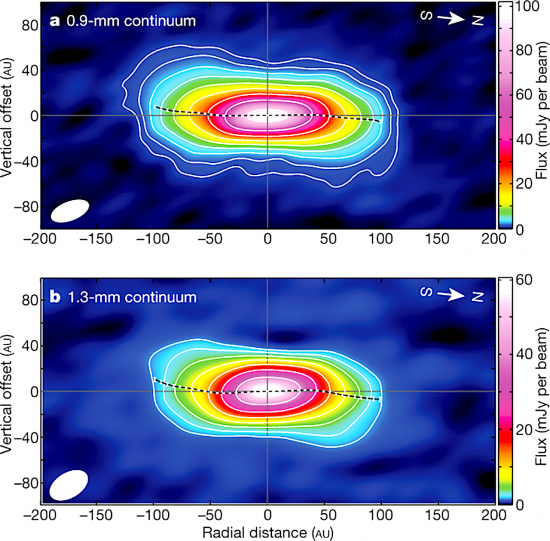
According to a recent press release, astronomers detected a warped dust ring around a presumed protoplanetary disk in the Taurus Molecular Cloud, located about 450 light years away.
A previous Picture of the Day discussed the warped ring of material surrounding the nucleus of Galaxy Centaurus A. Galaxies and stars appear to share evolutionary morphology, at least as far as conventional astronomers are concerned. NGC 5128 exhibits a transverse, donut-shaped plasma discharge. Observations conducted by the now defunct Herschel Space Observatory reveal that the Milky Way is also home to a twisted toroid of plasmas orbiting the galactic center.
Nami Sakai, the research group leader, wrote:
“This observation shows that it is conceivable that the misalignment of planetary orbits can be caused by a warp structure formed in the earliest stages of planetary formation. We will have to investigate more systems to find out if this is a common phenomenon or not.”
Consensus opinions state that stars and galaxies spin because of how they form. A hypothetical cloud of gas and dust contracts, causing its spin rate to increase. A disk of material then surrounds the central nucleus, while gravitational eddy-currents inside the disk pull material toward the center.
The spinning cloud is supposed to overcome its internal gravitational attraction with centrifugal force, flinging out material. How a randomly moving cloud of particles acquires a net spin is unexplained by consensus astronomers.
However, in an Electric Universe, stars are created within helical electric currents that form a great circuit through space. The Bennett pinch effect squeezes plasma inside these cosmic “transmission lines”, compressing vast clouds of ionized plasmas within electromagnetic fields, igniting the stars, while forming toroidal currents around their equators.
Since stars are part of a filamentary circuit that flows through the cosmos, they most likely spin because of electricity flowing through them. Stars exist within an inconceivably large filamentary circuit of electricity. There is no way to know where this charge flow rises, or to what electrode it is attracted, but we see the effects of its electromagnetic fields in the magnetism and synchrotron radiation that permeate space.
Electricity organizes itself within fields of plasma. Plasma is composed of neutral atoms, but a small percentage of charged particles are also present. Those particles, and the charge-neutral ones they sweep along with them, are driven by the larger electromagnetic field, creating “pinches” of matter, rather than a gravitational impetus from cold gas.
It was the Dutch physicist, Hendrik Lorentz, who found that the velocity and charge of a particle, as well as the strength of a magnetic field, influences its direction of travel. When electricity flows through a star inside a magnetic field, a force acts on the charges in the star, producing torque. The torque effect causes the star to spin around its pivot point. A force that is at right angles to both the direction in which a charged particle is moving and the direction of the applied field is called the “Lorentz force”.
As many Pictures of the Day point out, it is electricity that causes star formation and other activity in space. All star-forming regions reveal electric filaments, but they are only detectable by their influences. As previously written, that idea explains the tangential velocities discovered in stars near the outer regions of galaxies, as well as the Sun’s more rapid rotation at its equator than at its higher latitudes.
Stephen Smith












